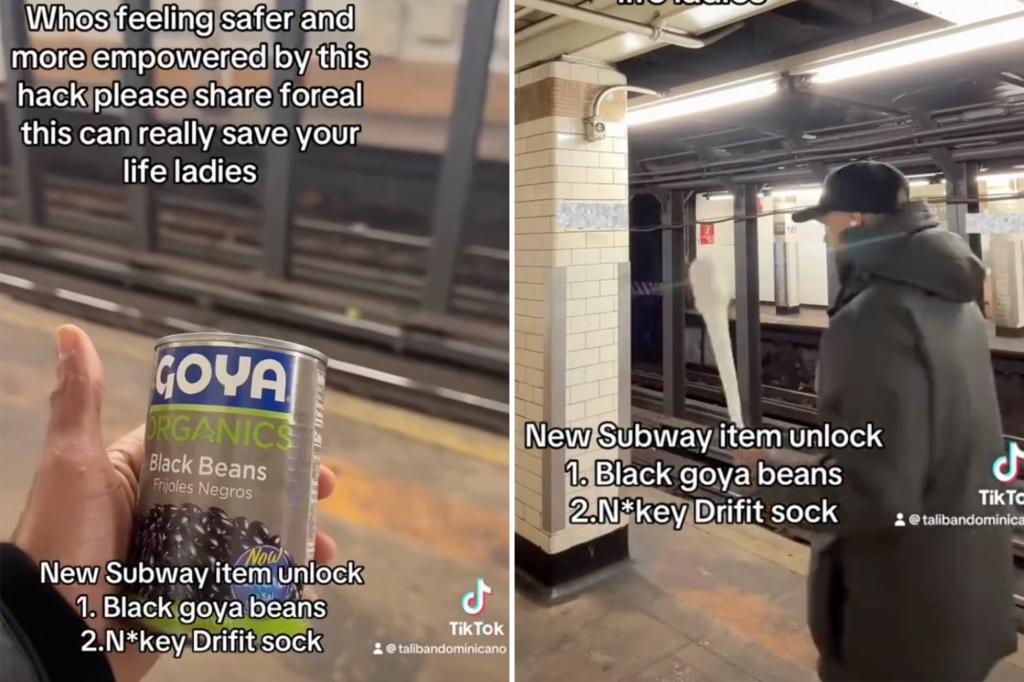The emergence of a novel self-defense tactic on social media highlights the growing concerns about personal safety, particularly for women, navigating public transportation systems like the New York City subway. This latest “hack” involves utilizing readily available items – a sock and a can of beans – to create an improvised weapon. The method, as demonstrated by TikTok user @talibandominicano, involves placing the can of beans inside a sock and swinging it as a defensive tool. The video’s viral popularity, amassing over 320,000 views and 45,000 likes, underscores the resonance of this approach with individuals seeking accessible and readily deployable self-defense options. While some commenters affirmed the method’s historical usage, dating back to the 1980s, and suggested alternative filler items like rolls of quarters, D batteries, or billiard balls, others expressed frustration at the added burden of carrying another item for personal safety, reflecting the complex interplay between practicality and perceived necessity in an environment of heightened security concerns.
The bean-in-a-sock approach reflects a broader trend of individuals seeking creative and often unconventional self-defense solutions in response to perceived threats in public spaces. This trend is fueled by widespread media coverage of assaults and attacks, often amplified on social media platforms, which create a heightened sense of vulnerability and fear, especially among women and other vulnerable populations. These DIY methods often utilize readily available items, transforming everyday objects into potential defensive tools. This resourcefulness underscores the proactive stance individuals are taking to protect themselves while also highlighting a potential gap in accessible and effective self-defense training and resources. The reliance on such improvised measures also raises questions about the perceived efficacy of official security measures and the underlying anxieties driving these individual responses.
The prevalence of these improvised self-defense techniques underscores a deeper societal concern regarding safety in public spaces, particularly on public transportation systems. The discussion surrounding these methods highlights the balance between individual responsibility for personal safety and the collective responsibility of authorities to provide a secure environment. While some argue that individuals should take proactive steps to protect themselves, others criticize the necessity of such measures, placing the onus on authorities to address the root causes of crime and violence. The burgeoning popularity of these DIY self-defense strategies suggests a degree of dissatisfaction with existing security measures and a desire for greater control over personal safety in situations perceived as potentially dangerous.
The anxiety surrounding personal safety on the subway is further exacerbated by the sporadic and often highly publicized incidents of violence. The video referencing the tragic murder of Debrina Kawam, who was burned alive on the subway, serves as a stark reminder of the potential for extreme violence and fuels the prevailing sense of fear and vulnerability. The TikToker’s decision to carry a fire extinguisher highlights the extreme measures individuals are taking to protect themselves, driven by fear and a desire to be prepared for any eventuality. This escalating trend of carrying improvised defensive tools, from cans of beans to fire extinguishers, reflects a growing sense of unease and a perceived need for enhanced personal security measures in the face of perceived threats.
The specific incidents cited, occurring in the final days of 2024 and the first days of 2025, involving stabbings, slashings, and a person being thrown onto the tracks, further contribute to the climate of fear and underscore the perceived dangers of riding the subway. These incidents, often amplified through media coverage and social media discussions, create a sense of immediacy and reinforce the perceived need for personal protection. The clustering of these violent incidents within a short time frame can significantly impact public perception and contribute to a heightened sense of vulnerability among subway riders. The fear generated by these events fuels the search for accessible and effective self-defense methods, further driving the popularity of DIY solutions like the bean-in-a-sock technique.
The rise of these improvised self-defense methods and the anxieties they represent warrant a broader conversation about public safety, the role of individual versus collective responsibility, and the need for effective crime prevention strategies. While personal safety is undoubtedly a paramount concern, the reliance on DIY solutions like the bean-in-a-sock technique raises questions about the adequacy of existing security measures and the underlying societal factors contributing to the perceived need for such measures. Addressing these concerns requires a multi-faceted approach, including improved lighting, increased police presence, and readily available emergency assistance on public transportation systems. Furthermore, promoting access to effective self-defense training and resources could empower individuals to protect themselves while also addressing the underlying anxieties driving the adoption of these often unconventional and potentially ineffective self-defense methods.

